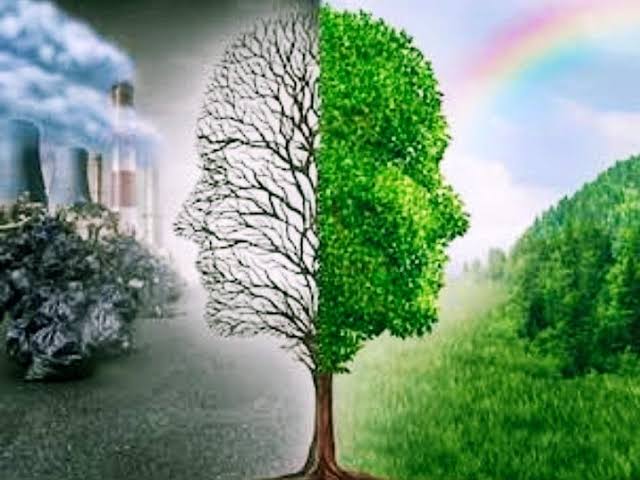Pollution: A Global Environmental Crisis

Introduction
Pollution is one of the most pressing environmental issues facing the world today. It refers to the introduction of harmful substances or products into the environment, causing adverse effects on ecosystems and human health. Pollution can take many forms, including air, water, soil, noise, and light pollution. Understanding its causes, effects, and potential solutions is crucial for developing strategies to mitigate its impact.
Types of Pollution
1. Air Pollution:
Air pollution is the contamination of the atmosphere by harmful chemicals, particulate matter, and biological materials. Major sources include industrial emissions, vehicle exhaust, burning of fossil fuels, and agricultural activities. Common pollutants include sulfur dioxide (SO₂), nitrogen oxides (NOₓ), carbon monoxide (CO), volatile organic compounds (VOCs), and particulate matter (PM10 and PM2.5). Air pollution contributes to respiratory diseases, cardiovascular problems, and global warming.

2. Water Pollution:
Water pollution occurs when harmful substances enter water bodies such as rivers, lakes, oceans, and groundwater. Key sources include industrial discharge, agricultural runoff, sewage and wastewater, and oil spills. Pollutants like heavy metals, pesticides, plastics, and pathogens can lead to waterborne diseases, ecosystem damage, and disruption of aquatic life.

3. Soil Pollution:
Soil pollution involves the contamination of soil with hazardous chemicals and waste. Major contributors include industrial activities, agricultural practices (pesticides and fertilizers), improper waste disposal, and mining. Contaminants such as heavy metals, hydrocarbons, and toxic chemicals can reduce soil fertility, harm plant life, and pose health risks to humans and animals through the food chain.

4. Noise Pollution:
Noise pollution refers to excessive or harmful levels of noise in the environment. Common sources are traffic, industrial operations, construction activities, and urbanization. Prolonged exposure to high noise levels can lead to hearing loss, stress, sleep disturbances, and cardiovascular issues.

5. Light Pollution:
Light pollution is the excessive or misdirected artificial light in the environment. It is caused by streetlights, commercial properties, residential areas, and advertising billboards. Light pollution disrupts natural sleep patterns, affects wildlife behavior, and obscures the night sky, hindering astronomical observations.

Causes of Pollution
Pollution is primarily driven by human activities. Key causes include:
- Industrialization: Factories and power plants release large amounts of pollutants into the air, water, and soil.
- Transportation: Vehicles emit exhaust gases that contribute to air pollution and global warming.
- Agriculture: The use of pesticides, fertilizers, and animal waste can lead to water and soil contamination.
- Urbanization: Rapid urban growth leads to increased waste generation, energy consumption, and habitat destruction.
- Deforestation: Clearing forests for agriculture or development reduces the Earth's capacity to absorb CO₂, contributing to air pollution and climate change.
Effects of Pollution
The effects of pollution are wide-ranging and severe, impacting both the environment and human health:
- Health Impacts: Exposure to pollutants can cause respiratory diseases, cardiovascular conditions, cancer, neurological disorders, and developmental issues in children.
- Environmental Damage: Pollution harms ecosystems, reducing biodiversity, and disrupting food chains. It can lead to habitat loss, water acidification, soil degradation, and climate change.
- Economic Costs: Pollution incurs significant economic costs through healthcare expenses, loss of productivity, environmental cleanup, and damage to natural resources.
- Climate Change: Greenhouse gases like CO₂ and methane (CH₄) contribute to global warming, leading to extreme weather events, sea-level rise, and shifts in ecosystems.
Solutions to Pollution
Addressing pollution requires a multifaceted approach involving policy, technology, and community action:
- Regulations and Policies: Governments can implement stricter environmental regulations, enforce emissions standards, and promote sustainable practices.
- Technological Innovation: Advancements in clean energy, waste management, and pollution control technologies can reduce emissions and improve efficiency.
- Public Awareness: Educating the public about the causes and effects of pollution can encourage more sustainable behaviors and consumer choices.
- International Cooperation: Global challenges like climate change and ocean pollution require international collaboration and agreements, such as the Paris Agreement.
- Sustainable Practices: Adopting sustainable agricultural practices, reducing single-use plastics, and promoting recycling and conservation efforts can mitigate pollution.
Conclusion
Pollution is a critical global issue that demands immediate and sustained action. Its multifaceted nature requires a comprehensive approach involving policy changes, technological advancements, public engagement, and international cooperation. By addressing the root causes and implementing effective solutions, we can protect the environment and ensure a healthier, more sustainable future for generations to come.




